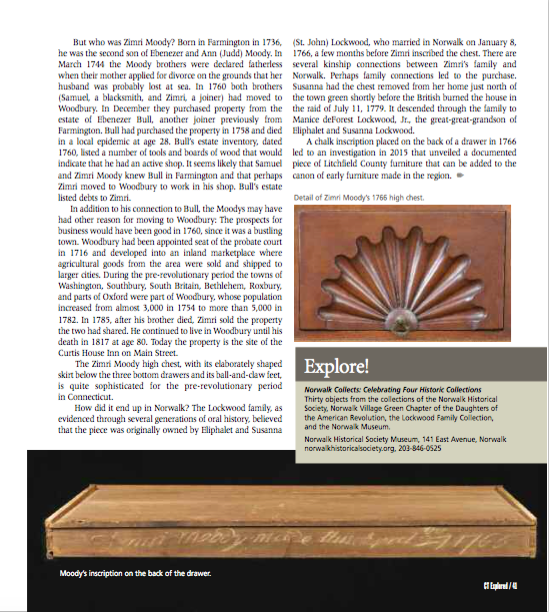by Elizabeth Pratt Fox and Lynn Friedman
(c) Connecticut Explored Inc. SUMMER 2016
Subscribe/Buy the Issue!
Finding a piece of furniture by a known cabinetmaker is always exciting, but discovering the only known piece by a little-known cabinetmaker is thrilling. We experienced that thrill while examining this piece to include in “Norwalk Collects: Celebrating Four Historic Collections,” a long-term exhibition now on view at the Norwalk Historical Society Museum.
Among the objects we were considering was a late 18th-century high chest of drawers bequeathed to the City of Norwalk by Manice deForest Lockwood, Jr. in 1977. Museum records noted an inscription in chalk on the back of a drawer that said: “[L? or J?] Moody Made This April 27, 1766.” That interpretation of the inscription had led the chest to be attributed to James Moody, a known cabinet-maker from Newport, Rhode Island. A note in the records, however, indicated that when Patricia E. Kane, curator of decorative arts at the Yale University Art Gallery, examined the piece in 2011 as part of the Rhode Island Furniture Archive, she determined that the chest was probably made in Connecticut. Intrigued and more than a little curious, we made an appointment to retrieve the piece from storage and view it in person. Meanwhile, we reached out to colleagues in the field, perused published examples of Connecticut furniture, and dove into census records looking for Moodys in Connecticut. We discovered that a joiner named Zimri Moody (1736-1817) working in Woodbury after 1760 was cited in Edward S. Cooke Jr.’s Making Furniture in Preindustrial American: The Social Economy of Newtown and Woodbury, Connecticut.
When the day of examination came we waited with bated breath as the signed drawer was removed from the chest. To our delight what was thought to have been an “L” or “J” was actually a “Z” — and in fact the unusual name was actually spelled out. The first part of the puzzle was solved: “Zimri Moody Made This April 27, 1766.”
But who was Zimri Moody? Born Farmington in 1736, he was the second son of Ebenezer and Ann (Judd) Moody. In March 1744 the Moody brothers were declared fatherless when their mother applied for divorce on the grounds that her husband was probably lost at sea. In 1760 both brothers (Samuel, a blacksmith and Zimri, a joiner) had moved to Woodbury. In December they purchased property from the estate of Ebenezer Bull, another joiner previously from Farmington. Bull had purchased the property in 1758 and died in a local epidemic at age 28. Bull’s estate inventory, dated 1760, listed a number of tools and boards of wood that would indicate that he had an active shop. It seems likely that Samuel and Zimri Moody knew Bull in Farmington and that perhaps Zimri moved to Woodbury to work in his shop. Bull’s estate listed debts to Zimri.
In addition to his connection to Bull, the Moodys may have had other reason for moving to Woodbury: The prospects for business would have been good in 1760, since it was a bustling town. Woodbury had been appointed seat of the probate court in 1716 and developed into an inland marketplace where agricultural goods from the area were sold and shipped to larger cities. During the pre-revolutionary period the towns of Washington, Southbury, South Britain, Bethlehem, Roxbury, and parts of Oxford were part of Woodbury, whose population increased from almost 3,000 in 1754 to more than 5,000 in 1782. In 1785, after his brother died, Zimri sold the property the two had shared. He continued to live in Woodbury until his death in 1817 at age 80. Today the property is the site of the Curtis House Inn on Main Street.
The Zimri Moody high chest, with its elaborately shaped skirt below the three bottom drawers and its ball-and-claw feet, is quite sophisticated for the pre-revolutionary period in Connecticut.
How did it end up in Norwalk? The Lockwood family, as evidenced through several generations of oral history, believed that the piece was originally owned by Eliphalet and Susanna (St. John) Lockwood, who married in Norwalk on January 8, 1766, a few months before Zimri inscribed the chest. There are several kinship connections between Zimri’s family and Norwalk. Perhaps family connections led to the purchase. Susanna had the chest removed from her home just north of the town green shortly before the British burned the house in the raid of July 11, 1779. It descended through the family to Manice deForest Lockwood, Jr., the great-great-grandson of the original owners, Eliphalet and Susanna Lockwood.
A chalk inscription placed on the back of a drawer in 1766 led to an investigation in 2015 that unveiled a documented piece of Litchfield County furniture that can be added to the canon of early furniture made in the region.
Elizabeth Pratt Fox is a museum consultant and curator of the exhibition Norwalk Collects: Celebrating Four Historic Collections. She has written two previous articles for Connecticut Explored: “The Case of the Missing Overmantel,” (Volume 5, Number 1, Winter 2006/2007) and “The Trumbull Dynasty,” (Volume 8, Number 4, Fall 2010).
Lynn Friedman is an historic property researcher and curator of the exhibition Margaret Hoyt Smith: Norwalk’s First Female Architect.
Explore!
Read more stories about products and inventions Made in Connecticut on our TOPICS page.
LISTEN!
Listen to Betsy Fox on Grating the Nutmeg, the podcast of Connecticut history. Her interview starts around minute 30.


